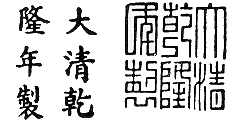| Qianlong 1736-95 The Yongzheng emperor nominated his fourth son, Hongli, meaning "Great Successor", as his heir and he ruled from 1736 to 1796 as the Qianlong or "eminent sovereign" emperor. He had been a great favorite of his grandfather, the Kangxi emperor, with whom he would go hunting as a boy. Some say that the Kangxi emperor chose Yongzheng as his successor so that he would eventually be succeeded by his grandson, although that would seem a rather risky prospect, as the Yongzheng emperor had ten sons (though only four survived into adulthood).
When Qianlong was on the throne China was flourishing, but as he left the throne it was beginning to decline. The long reign of the Qianlong emperor (who retired in 1796, three years before his death) may be considered the height of the Qing. Though his Ten Great Campaigns were not all as successful as he claimed, he brought much of Central Asia under Qing rule, vastly increasing the size of his empire. The costs of his campaigns were met by an increase in cultivated land, with new crops, such as maize and peanuts, being grown and with firm controls on revenue collection. Well versed in Chinese culture, the Qianlong emperor is supposed to have written essays and as many as 42,000 poems. He developed the imperial collection, commissioning paintings and artefacts from Chinese and foreign artists, as well as collecting ancient Chinese objects and ordering the cataloguing of palace paintings and calligraphy.
Like his grandfather Kangxi, the Qianlong emperor made five great tours of inspection of southern China, reversing the tradition of the Ming emperors who only left the Forbidden City to visit the imperial altars but did not venture outside Peking. His daily routine was described in detail by the Jesuit priest Fr Benoist. He rose at six, ate alone at eight (his meal taking about 15 minutes) and then read reports and memorials, discussing them with his ministers. He held an audience for newly appointed officials and had another brief solitary meal at two. Then he would read, write verse or paint and perhaps take some 'light refreshment' before bed. Unlike the Chinese, the Qianlong emperor took milk in his tea, with special herds of dairy cows providing the Manchu imperial family with milk. A menu for one of his meals in 1754 included a dish of fat chicken, boiled duck and bean curd, swallows nests and shredded smoked duck, smoked chicken, shredded stewed chicken, Chinese cabbage, salted duck and pork, bamboo-shoot steamed dumplings, rice cakes with honey and side dishes of pickled eggplant, pickled cabbage and cucumbers in soy sauce
In the 60th year of his reign (1796), the Qianlong Emperor enthroned his son and became overlord for four years. In the 4th year of the Jiaqing reign (1799) the Qianlong Emperor died at age 89.
During this period the archaic zhuanshu seal mark is by far the most common, largely ousting the regular kaishu script. It is thought that the few genuine kaishu marks dates to the two first years of the reign before the official seal mark of the Qianlong period becomes standardized by an official decree. Seal marks are often written in iron-red but under glaze blue or gilt can occur as well as incised, stamped or molded in relief. On a small group of porcelain genuine marks in raised blue enamel can appear. Seal marks from the period can also be written in a cartouche or with the seal broken up, and on the base of stem-cups written in a horizontal row from right to left.
On later Qianlong copies the seal mark in red enamel is something of a favorite. 
|
